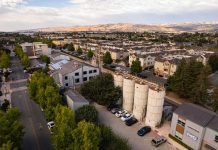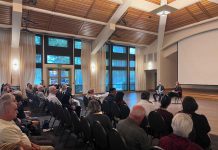With the exception of Stanford University lands, no single area
of Santa Clara County has required more attention from the
Committee for Green Foothills in recent years than the Coyote
Valley, south of San Jose.
By Brian Schmidt
With the exception of Stanford University lands, no single area of Santa Clara County has required more attention from the Committee for Green Foothills in recent years than the Coyote Valley, south of San Jose.
By targeting Coyote Valley for development 30 years ago, San Jose city managers began to emulate Los Angeles-style sprawl. Over the years, as various plans to develop this rich agricultural area have surfaced, Committee for Green Foothills has fought each of them.
San Jose’s rash decision in 2000 to approve a giant campus for Silicon Valley’s Cisco Systems sparked the most serious effort yet to develop Coyote Valley. Despite the economic downturn, the vacant offices downtown, and the realization that Cisco’s project will almost certainly not be built, San Jose continues to plan for 50,000-plus jobs and 25,000 homes in the last agricultural stronghold north of Morgan Hill.
Our goals remain: (1) stop this unnecessary and poorly planned development, (2) delay it as long as possible or (3) if it does go forward, decrease its impacts.
The forthcoming preparation of an Environmental Impact Report for the region’s development will reveal the future of San Jose, and the Committee is following it all very closely.
There are economic costs associated with this sprawl.
San Jose remains irrationally focused on development in Coyote Valley, and it is doing so with blinders on. City officials are also advocating redevelopment downtown and in the North First Street area. Despite a more-than-adequate supply of commercial and industrial space elsewhere, the movement for massive development and farmland destruction in Coyote Valley continues.
Redeveloping downtown San Jose first, North First Street next, and then last (and only if necessary) Coyote Valley seems a smarter plan than the current “sprawl everywhere” option favored by the City.
In an effort to promote sound land use planning, CGF is highlighting how development in Coyote Valley will hurt redevelopment efforts elsewhere. Environmentally destructive projects have real economic costs.
By using these economic arguments to force a discussion of priorities, we hope to finally draw the attention of the rest of the political actors in San Jose. Until now, they have been content to allow Coyote Valley developers drive the process forward.
Coyote Valley could determine the future of proposed BART extension.
San Jose’s planning for Coyote Valley may ultimately determine whether the Bay Area Rapid Transit (BART) line gets extended to San Jose.
If Coyote Valley moves forward as contemplated, it indicates that San Jose is committed to sprawl, and does not intend to achieve the level of dense development in San Jose needed to support a viable BART line.
Environmentalists may then be forced to recommend that voters spend limited transportation funding on other projects.
Given how important BART seems to be for some parts of the San Jose establishment, we are suggesting that these BART supporters take steps to make sure Coyote Valley poses less of a threat to the city.
The forthcoming Environmental Impact Report process for Coyote Valley will be a test of how San Jose will manage these challenges. CGF remains committed to sound land use planning that will protect Coyote Valley and ensure a more livable region.
This article may also be viewed at www.GreenFoothills.org
Brian Schmidt is on the Santa Clara County Legislative Advocate Committee for Green Foothills. He can be reached at Brian@GreenFoot hills.org or 650-968-7243. Readers interested in writing a guest column should contact editor Walt Glines at ed******@*************es.com or 408-779-4106.







